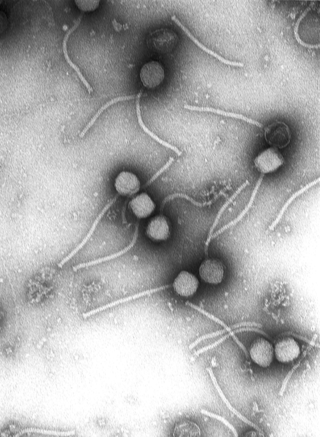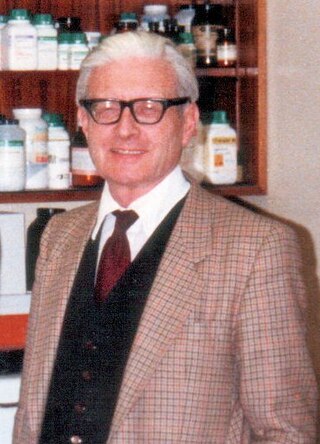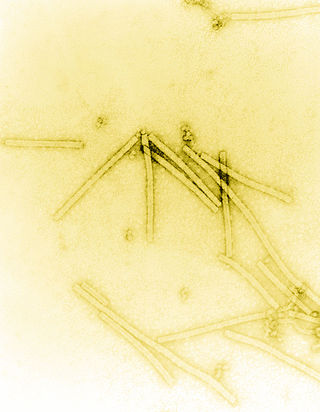Related Research Articles

Virology is the scientific study of biological viruses. It is a subfield of microbiology that focuses on their detection, structure, classification and evolution, their methods of infection and exploitation of host cells for reproduction, their interaction with host organism physiology and immunity, the diseases they cause, the techniques to isolate and culture them, and their use in research and therapy.

Thomas Henry Flewett, MD, FRCPath, FRCP was a founder member of the Royal College of Pathologists and was elected a Fellow of the Royal College of Physicians of London in 1978. He was chairman of the World Health Organization (WHO) Steering Committee on Viral Diarrhoeal Diseases, 1990–3, and a member until 1996. His laboratory in Birmingham was a World Health Organization Reference and Research Centre for Rotavirus Infections from 1980 until his retirement in 1987. He was an external examiner, visiting lecturer, and scientific journal editor. He was a member of the board of the Public Health Laboratory Service from 1977 to 1983 and was chairman of the Public Health Laboratory Service's Committee on Electron Microscopy from 1977 to 1987.
In the diagnostic laboratory, virus infections can be confirmed by a myriad of methods. Diagnostic virology has changed rapidly due to the advent of molecular techniques and increased clinical sensitivity of serological assays.

The history of virology – the scientific study of viruses and the infections they cause – began in the closing years of the 19th century. Although Louis Pasteur and Edward Jenner developed the first vaccines to protect against viral infections, they did not know that viruses existed. The first evidence of the existence of viruses came from experiments with filters that had pores small enough to retain bacteria. In 1892, Dmitri Ivanovsky used one of these filters to show that sap from a diseased tobacco plant remained infectious to healthy tobacco plants despite having been filtered. Martinus Beijerinck called the filtered, infectious substance a "virus" and this discovery is considered to be the beginning of virology.

Charlotte Friend was an American virologist. She is best known for her discovery of the Friend leukemia virus. She helped to establish the concept of the oncovirus, studied the role of the host immune response in disease development, and helped define modern retrovirology.
Hon. Richard Tedder FRCP is an English virologist and microbiologist, was head of the Department of Virology at the University College London Medical School, and worked as virologist at Public Health England
Peter K. Vogt is an American molecular biologist, virologist and geneticist. His research focuses on retroviruses and viral and cellular oncogenes.

June Dalziel Almeida was a Scottish virologist, a pioneer in virus imaging, identification, and diagnosis. Her skills in electron microscopy earned her an international reputation.

George Keble Hirst, M.D. was an American virologist and science administrator who was among the first to study the molecular biology and genetics of animal viruses, especially influenza virus. He directed the Public Health Research Institute in New York City (1956–1981), and was also the founding editor-in-chief of Virology, the first English-language journal to focus on viruses. He is particularly known for inventing the hemagglutination assay, a simple method for quantifying viruses, and adapting it into the hemagglutination inhibition assay, which measures virus-specific antibodies in serum. He was the first to discover that viruses can contain enzymes, and the first to propose that virus genomes can consist of discontinuous segments. The New York Times described him as "a pioneer in molecular virology."
Werner Henle and Gertrude Henle were a husband and wife team of virologists known for their work in flu vaccines and viral diagnostics. Together they authored more than 200 papers.
Jay A. Levy, M.D. is an AIDS and cancer research physician. He is a professor of medicine with specialties in virology and immunology at the University of California, San Francisco (UCSF).

Sonja Buckley was a Swiss-born virologist. She was the first person to culture Lassa virus, the causative agent of Lassa fever, a potentially deadly disease that originated in Africa.

Margrét Guðmunda Guðnadóttir was an Icelandic doctor and virologist and the first woman to become a professor at the University of Iceland.
Patricia Gail Spear is an American virologist. She is a professor emeritus of microbiology and immunology at Northwestern University in Evanston, Illinois. She is best known for her pioneering work studying the herpes simplex virus. Spear is a past president of the American Society for Virology and an elected member of the National Academy of Sciences.
Gibbon-ape leukemia virus (GaLV) is an oncogenic, type C retrovirus that has been isolated from primate neoplasms, including the white-handed gibbon and woolly monkey. The virus was identified as the etiological agent of hematopoietic neoplasms, leukemias, and immune deficiencies within gibbons in 1971, during the epidemic of the late 1960s and early 1970s. Epidemiological research into the origins of GaLV has developed two hypotheses for the virus' emergence. These include cross-species transmission of the retrovirus present within a species of East Asian rodent or bat, and the inoculation or blood transfusion of a MbRV-related virus into captured gibbons populations housed at medical research institutions. The virus was subsequently identified in captive gibbon populations in Thailand, the US and Bermuda.
Wallace Prescott Rowe was an American virologist, known for his research on retroviruses and oncoviruses and as a co-discoverer of adenoviruses.
Xiang-Jin Meng, also known as X.J. Meng, is a Chinese-born American virologist. He is a university distinguished professor at Virginia Tech. He studies emerging, re-emerging and zoonotic viruses of veterinary and human public health significance. He was elected a member of the National Academy of Sciences in 2016, a Fellow of the National Academy of Inventors in 2014, and a Fellow of the American Academy of Microbiology in 2012.
Jacoba G. Kapsenberg is a Dutch retired virologist who worked at the National Laboratory of Public Health, Utrecht, the Netherlands, from 1954 until 1989. There, she was responsible for viral diagnostics and developing the laboratory to the level of a national reference laboratory.
Anne Moscona is an American virologist and pediatrician. She is best known for identifying cell entry mechanisms for enveloped respiratory viruses, elucidating general infection mechanisms that apply to parainfluenza virus, Nipah virus, measles virus, and other viruses, and for applying this knowledge to identify antiviral strategies to prevent infection by viruses including SARS-CoV-2. She is frequently consulted as a medical expert during viral outbreaks, including epidemic and pandemic influenza. Since 2016, she has served as the Sherie L. Morrison Professor Microbiology & Immunology, Professor of Pediatrics, and Professor of Physiology & Cellular Biophysics at Columbia University Medical Center in New York City, where she directs the Center for Host Pathogen Interaction. In 2022, Moscona was elected as president of the American Society for Virology, the nation's leading virology research organization, and will lead the organization starting in July 2023. For the last two years she has served the American Society for Virology as Councilor for Medical Virology.
Edwin Herman Lennette was an American physician, virologist, and pioneer of diagnostic virology.
References
- 1 2 3 4 5 6 7 8 9 10 11 12 13 14 15 16 "Yale Bulletin and Calendar". archives.news.yale.edu. Retrieved 2021-06-23.
- 1 2 3 4 5 6 7 8 9 Lucci-Canapari, Jeanna. "Committed virologist, veteran of the Chinese Civil War". medicine.yale.edu. Retrieved 2021-06-23.
- 1 2 3 4 5 6 7 8 9 10 11 "Dr. Hsiung, long time friend of Hubei Medical College (WUSM), passed away". www.wuda-alumni.org. Retrieved 2021-06-23.
- 1 2 3 4 5 6 7 8 Landry, M. L. (1989). "G.D. Edith Hsiung, Ph.D.: virologist and teacher". The Yale Journal of Biology and Medicine. 62 (2): 62–77. ISSN 0044-0086. PMC 2589211 . PMID 2672621.
- 1 2 3 "Collection: G. D. Hsiung Papers".
{{cite web}}: CS1 maint: url-status (link) - 1 2 3 4 "Edith Hsiung". medicine.yale.edu. Retrieved 2021-06-23.
- ↑ "Yale Bulletin and Calendar". archives.news.yale.edu. Retrieved 2022-02-09.